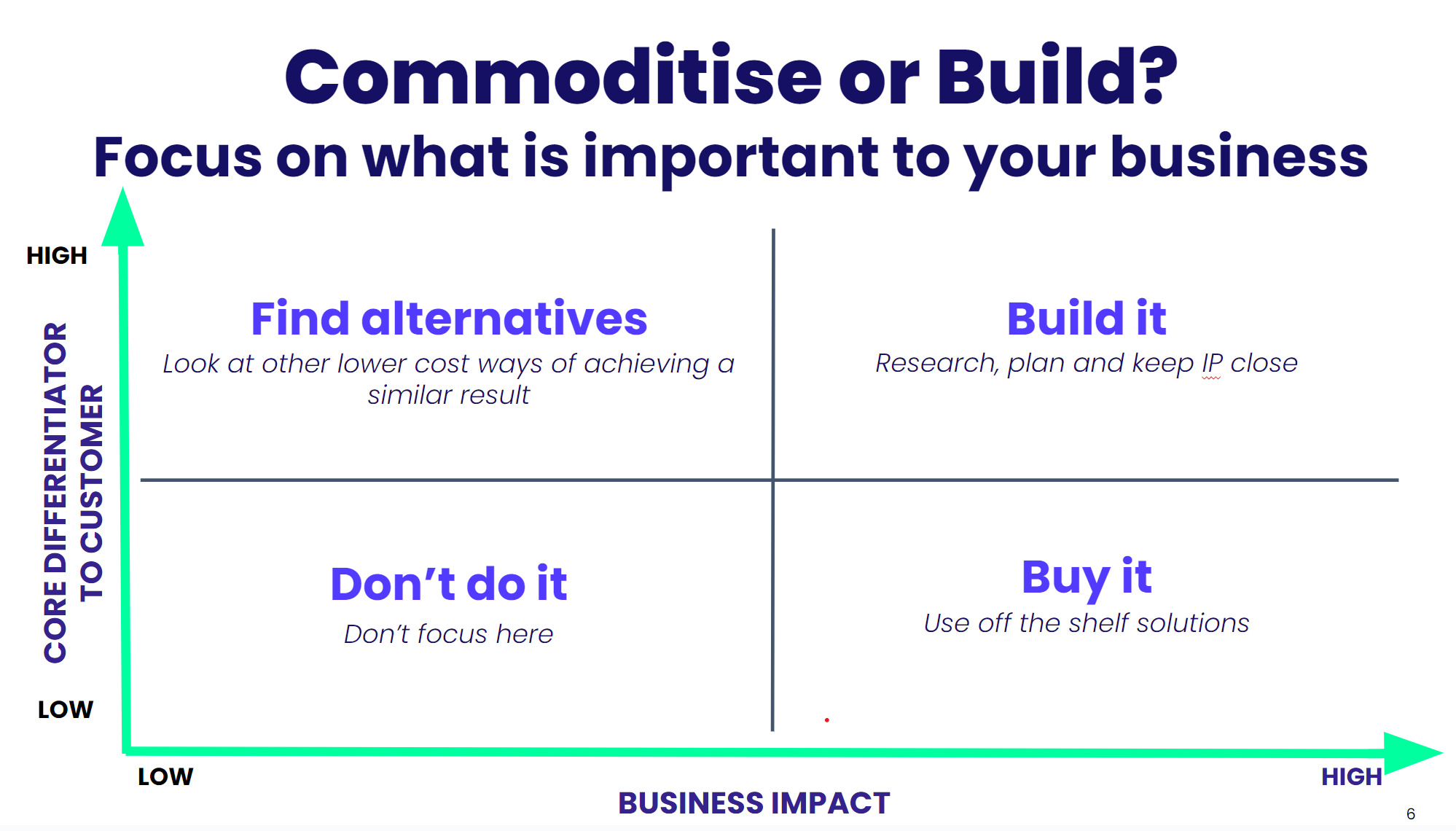Artificial Intelligence is becoming an integral element in the business strategies of many forward-thinking companies. As these companies begin to take greater advantage of this technology, identifying and deploying the right AI strategy—aligned with solid data foundations—becomes essential.
AI’s transformative power isn’t derived solely from its integration into business models, but more significantly, from the strategic application of its capabilities to solve core problems, enhance operational efficiency, and create value.
It’s not about leveraging AI for the sake of jumping on the bandwagon of technological advancements but about meticulously aligning its functionalities with organisational objectives to drive meaningful impacts.
In this article, we will help you understand how AI can help you solve business specific problems, provide a strategic framework to help you decide whether to build AI applications or use prebuilt ones, discuss the pros and cons of both approaches and examine the data foundations needed for each.
1. Kleene.ai Strategic Matrix for implementing AI applications
In an ever-evolving business landscape, it’s crucial for companies to be strategic about where they invest their resources. AI, despite its enormous potential, is no exception. The risk of misdirection is high, and without a clear framework, businesses can find themselves sinking time and resources into endeavours with minimal returns.

Our proposed 2×2 matrix isn’t just another business model; it’s a distillation of years of hands-on experience and strategic understanding. The vertical axis, representing “Core differentiator to customer,” and the horizontal one, showcasing “Business Impact,” provide businesses with a clear overview on where to focus:
- High Impact & Core Differentiator: These are golden opportunities, the initiatives that can redefine a brand, consider building AI initiatives from scratch
- High Impact but Not Core: While they’re crucial, they’re not unique to your brand essence. This is where strategic collaborations and outsourcing shine.
- Low Impact & Core Differentiator: Analyse the situation and evaluate if the return on investment justifies the effort.
- Low Impact & Not Core: Analyse the situation and evaluate if the return on investment justifies the effort.
At Kleene, having advised and collaborated with many dozens of retail businesses, we’ve built up a repository of knowledge on how to effectively operate a retail data strategy which gives tangible results. In leveraging this framework, businesses don’t just get a theoretical model; they get the cumulative wisdom of industry experts who’ve been there and done that.
2. What to consider for a Successful implementation?
With the proliferation of advanced AI solutions, it’s crucial to implement only those that amplify, rather than overshadow, the essence of your customer proposition. This means that several considerations should take precedence when thinking about implementing an AI application:
1. Customer Priorities: It’s not just about what you can offer, but what your customers genuinely need. Address their most pressing concerns and preferences.
2.Perception of Your Brand: In the process of innovation, ensure you don’t stray too far from the core attributes and values that your customers associate with and appreciate about your brand.
3.Competitive Elements: In the race to be the best, your AI implementations should not only match but ideally surpass the capabilities of your competitors, solidifying your market position.
4.Strategic Alignment: Every technological advancement should be a stepping stone towards achieving the overarching goals of your business, echoing the vision and mission that underpins your brand.
By prioritizing these considerations, you can ensure that the AI applications you implement amplify, rather than overshadow, the essence of your customer proposition. This will lead to successful and impactful implementations that drive tangible results for your brand.
3. Building Your Own AI apps
The allure of in-house AI solutions is undeniable. Tailor-made solutions that address your unique challenges can propel your business ahead of the competition. However, it’s crucial to understand the depth and breadth of commitment required in building and maintaining proprietary AI models:
1.Expertise: Crafting AI necessitates a team of data scientists and domain experts for design, training, and fine-tuning.
Data Management: Beyond collecting data, ensuring its quality and relevance is pivotal.
2.Resources: Advanced AI requires substantial computational capabilities.
3.Adaptability: AI is ever-evolving; continuous updates and learning are essential to remain current.
4.Ethics & Regulations: Handling vast data brings ethical challenges and regulatory constraints, making user privacy and transparency paramount.
5.Costs: Apart from initial setup, consistent financial input is needed for updates, scaling, and training.
6.Time: Developing reliable AI is a long-haul game, with timelines extending from months to years. Given how fast the industry is evolving, it makes sense to bet more on a narrow core area instead of achieving limited progress in a wider space and risk making moderate progress.
Considering these factors will help you make informed decisions about whether to pursue in-house AI solutions. While there are undeniable benefits to having full control over your AI models, it’s important to weigh the commitment and resources required against the potential advantages. In some cases, leveraging prebuilt AI apps or strategic collaborations may be a more practical and cost-effective option. Ultimately, the decision should align with your overall business goals and strategy.
4. Using Prebuilt AI APPS
Companies are increasingly exploring AI solutions that, while not central to their operations, have a transformative potential. Several of these technologies fit the “High Impact but Not Core” category, offering substantial benefits to those who harness them, some examples are:
1. Churn Prediction: it enables to forecasts customer attrition, allowing businesses to put strategies in place to enhance retention.
2. Advanced Marketing Attribution: By identifying the origin of marketing successes, companies can better allocate resources and refine strategies for higher ROI.
3.Inventory Optimisation: An essential for businesses with physical products, this ensures the right balance of stock is maintained, minimising waste and maximising availability
4.Customer Segmentation: By classifying customers based on their behaviours and preferences, companies can launch more targeted and effective marketing campaigns.
5.Advanced Personalisation: In an age of tailored experiences, this app curates individualised interactions, enhancing user engagement and satisfaction.
6. Demand Forecasting: By predicting the future demand for products or services, businesses can optimise their operational and marketing strategies.
At Kleene we have seen that Improvements in these areas can lead to a 2-10% uptick in critical metrics, such as inventory turnover, customer retention, and reduced acquisition costs. The cumulative effect of these enhancements can be game-changing. The good news is that businesses don’t need to start from scratch. Off-the-shelf solutions are available, allowing companies to leverage these innovations using their existing teams and infrastructure
5. The Power of a Single Source of Truth
At the heart of impactful decision-making lies robust data management. A unified or single source of truth (SSOT) in data management isn’t just about creating a central repository; it’s about setting the stage for enhanced clarity, reliability, and simplicity in data-driven endeavours. Here’s why having an SSOT is invaluable:
Eradicating Inconsistencies: With multiple data sources, discrepancies are inevitable. Different teams might access slightly varied data, leading to inconsistent analyses and, consequently, inconsistent decisions. An SSOT ensures that everyone refers to and acts upon the same set of data, thereby promoting uniformity in actions and outcomes.
Simplified Maintenance & Updates: Managing updates, corrections, or additions becomes significantly streamlined with an SSOT. Instead of updating multiple databases and ensuring consistency across them, businesses can focus on maintaining a singular source. This not only reduces the chances of errors but also economises maintenance efforts.
Reducing Complexity: A fragmented data ecosystem can be a nightmare for data scientists, analysts and anybody relying on the data. Each data source might come with its format, update frequency, and reliability score. An SSOT eliminates this multiplicity, allowing professionals to focus on drawing insights rather than grappling with data integration challenges.
Cost Efficiency: In the long run, maintaining multiple data sources can be costly. Beyond the immediate storage costs, there’s an expenditure of time, effort, and resources in ensuring data reliability and consistency across platforms. An SSOT, by providing a centralised data management solution, can lead to significant cost savings.
Enhanced Collaboration: With an SSOT, cross-functional teams can collaborate more effectively. Whether it’s marketing, sales, product development, or customer support, each team can pull data from the same source, ensuring that collaborative efforts are based on a unified understanding of the data.
In essence, a Single Source of Truth isn’t a luxury; it’s a strategic imperative for businesses aiming to harness the power of data without getting entangled in the complexities of fragmented data management.
Conclusion
In an era where technology and innovation are paramount, unlocking the transformative power of AI, underpinned by a single source of truth, can yield ground-breaking results, particularly for retailers. This transformational approach is what we champion at Kleene. By implementing AI solutions rooted in unified and coherent data, we enable businesses to exploit AI’s transformative potential in high-impact areas effectively.
The journey through the realm of AI is not about deciding whether to integrate but discerning the optimal way to do so. At Kleene, we are your partners in navigating this journey.
To delve deeper into how to build a competitive advantage with AI for decision-making, we invite you to watch our on-demand webinar, “Build a Competitive Advantage with AI for Decision Making.”
Watch the Webinar Now to discover how you can leverage AI to drive informed and intelligent decision-making in your business!



